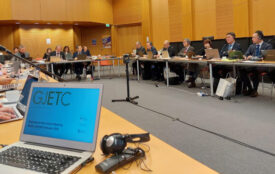Climate targets and SDGs achievable together with smart policy mix
Climate protection, food security and affordable energy are not mutually exclusive, shows a new study co-authored by the MCC. The competition for land is a key issue.
A broad combination of policies might be best suited to help achieve both climate stabilization targets as well as most of the UN Sustainable Development Goals. These policies reach from straightforward CO2 pricing to regulation of water and forest protection as well as lifestyle changes such as eating less meat. This is the result of a new study co-authored by the Mercator Research Institute on Global Commons and Climate Change (MCC) and led by the Potsdam Institute for Climate Impact Research (PIK). The scientists highlight the complex interplay between the different targets. A policy focused only on CO2 pricing would cost the least, they show, but would likely trigger substantial land-use changes.
“To keep global warming risks within the limits agreed by governments in the Paris Agreement, we need to fundamentally rebuild our energy systems,” says lead-author Christoph Bertram from PIK. “This will have profound effects in other areas that are relevant for the United Nations’ Sustainable Development Goals, creating both benefits and risks that are very immediate to the people, like on the one hand reduced air pollution and on the other hand higher prices for food and energy.” Assessing these trade-offs is crucial information for decision-makers. “This is the first study to analyze the impact of different policies on a range of sustainability elements,” says Bertram. “We find that a package of policies can greatly enhance the sustainability benefits of greenhouse-gas mitigation, and reduce the risks.”
The competition for land is one of the key issues here. “Without additional regulation, climate-only polices of a rapid phase-out of fossil-fuelled power generation would for example boost farming plants for generating bioenergy from them,” says co-author Alexander Popp from PIK. “This would reduce greenhouse-gas emissions, since burning the plants only releases the CO2 they have taken up while growning—yet it would also mean large-scale transformation of agricultural land otherwise used for food production, or for ecosystems that safeguard biodiversity. In the worst case, up to one third of today’s cropland area could be used for bioenergy plantations.”
“Some sustainability issues such as food security and access to affordable energy are more salient to the public than climate change—simply because the most severe impacts of global warming will occur in the future. Our study shows that both challenges can be tackled at once: It is possible to design smart climate policy packages that also ensure crucial progress in other key dimensions of human development,” says co-author Jan Minx from the MCC. “This is good news for governments and society: There is not one but a range of options.” The researchers analyzed 16 policy elements and 12 indicators related to 10 out of the 17 Sustainable Development Goals (SDGs), using computer simulations, explains Minx. “Scientists need to point out the specific benefits and disadvantages of different policies so that policy makers can make informed decisions.”
Even the policy package that scores best in most of the analysed sustainability indicators comes with a tradeoff: a broad combination of sustainability policies costs more money in the short-term than CO2 pricing alone. The pricing-only policy would keep energy generation costs in check and would in this respect be most cost-effective. Yet such a policy could lead to an increase of food prices by about one third in 15 years due to the use of land for climate change mitigation. In the end, this could potentially run counter the sustainable development goal of zero hunger. To avoid this unintended effect, additional policies would be needed.
The scientists emphasize that a higher cost of a broad combination of sustainability policies, compared with climate-only policy, is not the full picture. The analysis does not spell out climate damage costs that would arise if no policy action at all is taken – yet it is clear that the costs of non-action, both in terms of money and of human suffering, would be tremendous.
Both sustainability benefits and risks increase if ambition is raised to limiting global warming to 1.5 degrees, the aspirational goal mentioned in the Paris Agreement. “On the one hand, for instance coral reefs might be saved and a risk of long-term complete Greenland melting, resulting in substantial sea-level rise, would be reduced,” says co-author Gunnar Luderer from PIK. “On the other hand, economic short-term costs could triple and long-term costs double. This is because we would have to reduce fossil fuel use much faster, and also rapidly scale up the availability of CO2 removal from the atmosphere by using for instance carbon capture and storage technologies, CCS.”
“Yet, if CO2 pricing would be combined with dedicated policies, the sustainability challenges can be greatly reduced. To our great surprise, such dedicated policies can more than overcompensate the negative side-effects on for instance food and energy prices from strengthening the warming limit from 2 degrees to 1.5 degrees,” says Luderer. “This is an important insight: while more ambitious climate policy certainly is more expensive and hence consumes money needed for other sustainability goals such as poverty reduction, combining the climate policy with other policies can close the sustainability gap.”
Lifestyle changes turn out to be one of the most efficient pathways to complement CO2 pricing. If people reduce for instance airflight travel and meat consumption, this could be offsetting the higher short-term costs of early climate action. “While options to bring about such lifestyle changes often are very contentious and thus are not at the center of current policy discussions, these changes appear to have greatest potential for reducing sustainability risks and maximizing co-benefits of mitigation,” says Luderer. “Together, policies and people can achieve more than they think.”
Source
Mercator Research Institute on Global Commons and Climate Change (MCC) 2018








